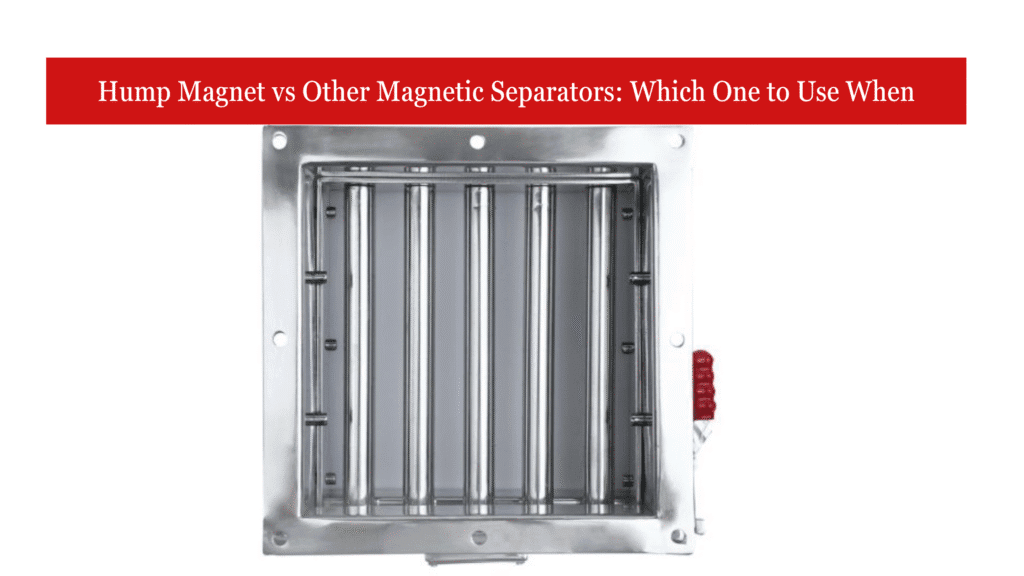Metal contamination in bulk products can lead to damaged machines, expensive recalls, and lower product quality. Magnetic separators help solve this issue by removing iron particles from powders, grains, pellets, and other materials. The big challenge is choosing the right magnetic separator for your production line.
This blog explains what a Hump Magnet is and how it compares with other magnetic separators. You will learn when to use each type and how to make the best decision for your industry and process.
What is a Hump Magnet
A Hump Magnet is designed for gravity-fed material. It is used in chutes and spouts where the product falls from one stage to another. The magnet housing has a zig-zag shape. Inside the housing, there are two powerful plate magnets installed one after the other. When the material falls through the chute, it first hits the top magnet, changes direction, and then falls onto the second magnet. This improves the chances of catching ferrous contamination.
Main benefits of a Hump Magnet
• Best for free-falling powder, granules, and coarse material
• Works well with products that do not flow smoothly
• Strong removal of tramp iron
• Good protection for machines like crushers, extruders, and mills
Points to consider
• Needs enough installation height and space
• Cleaning often requires stopping product flow
• Not suitable for horizontal conveyor belts
Hump magnets are popular in food, grain, plastic, chemical, and pharmaceutical processing because they provide very high iron removal in gravity lines.
Other Common Magnetic Separators and When They Work Best:
There are several other magnetic separators used in industries. Each one is suitable for a different flow and application.
Plate Magnet
A plate magnet is a flat magnetic surface installed over or under the product flow. It is commonly used above conveyor belts or along angled slides.
• Simple design and easy to maintain
• Best when material flows smoothly and forms a thin layer
• Not ideal if product clumps or bridges
• Contact with the magnet may be limited in free-fall conditions
Drawer Magnet
Drawer magnets have multiple magnetic tubes inside a pull-out drawer. Product flows around the tubes, and fine metal contaminants stick to the surface.
• Best for free-flowing powders and small granules
• Easy cleaning by pulling out the drawer
• Good performance for fine metal particles
• Can clog with sticky or large particles
• Not ideal for heavy pieces of tramp iron
Grate Magnet
A grate magnet is similar to a drawer magnet but is often installed directly in a hopper or bin. Material flows across a grid of magnet bars.
• Low cost and effective in simple applications
• Good for free-flowing dry materials
• Can block if the material is sticky or not uniform
• Cleaning may require more effort
Magnetic Drum or Pulley
This type is used on large conveyor belts in industries like recycling and mining. The rotating drum continuously pulls out metal contaminants.
• Good for removing large tramp metal pieces
• Continuous operation without stopping production
• Not suitable for gravity chutes or sanitary food lines
• Bigger equipment and higher cost
How to Decide Which Magnetic Separator to Use
There are five key questions to ask before selecting a magnetic separator.
1. How does your product move
• Free-falling product is ideal for hump magnets
• Conveyor belt flow is better for plate magnets or drum magnets
• Smooth-flowing powders work well with drawer and grate magnets
2. What size and type of metal needs to be removed
• Large nuts, bolts, and broken tools are caught best with hump magnets or drum magnets
• Very fine iron particles might need strong rare-earth drawer magnets
• Mixed-size contaminants may require a combination of systems
3. How often do you need to clean the magnet
• If cleaning must be quick and easy, drawer magnets offer faster access
• Hump magnets may require flow interruption unless a special design is chosen
• Some systems are available in self-cleaning models
4. How much installation space is available
• Hump magnets need a zig-zag chute section with enough height
• Plate magnets can fit in tight places
• Drum magnets require more width due to rotation mechanisms
5. What are your safety and hygiene requirements
Food and pharmaceutical companies often need stainless steel designs that comply with industry safety standards. Hump magnets are often installed before packaging to ensure a clean product with no risk of metal reaching the final consumer.
Real World Examples
To make the comparison easier, here are some real situations:
• A plastic manufacturing plant installs a hump magnet under a storage silo to stop nuts, bolts, or tools from entering the extruder
• A flour mill installs a hump magnet because flour often bridges or clumps inside chutes
• A sugar processing unit uses drawer magnets since sugar flows smoothly and needs frequent sanitary cleaning
• A recycling center uses drum magnets to remove large metal pieces from conveyor belts
These examples show that each separator solves a different type of problem.
Final Conclusion
All magnetic separators help remove ferrous contamination, but they do not work the same way. The correct equipment must match the flow conditions, material type, and contamination level.
Here is a clear takeaway:
• Use a Hump Magnet if your material is falling freely and may not flow smoothly
• Use a Plate Magnet if the material moves on a conveyor or slides evenly
• Use a Drawer or Grate Magnet if you are handling smooth-flowing powders
• Use a Drum or Pulley Magnet if you need continuous removal of large metal on conveyors
Choosing the correct separator improves product purity, protects expensive machines, reduces downtime, and increases profit.

